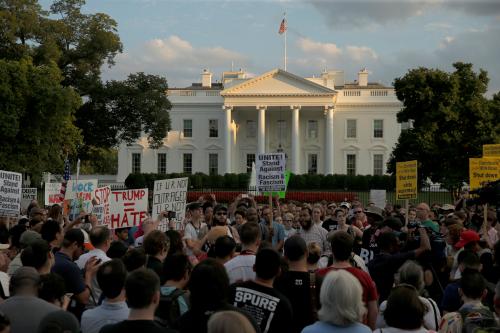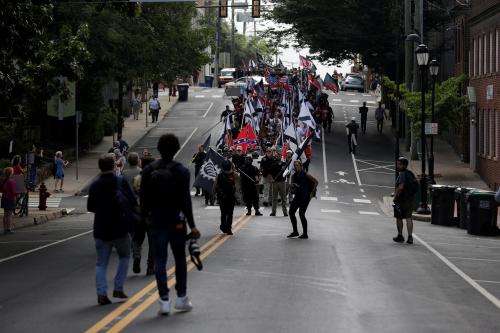More than 50 years after the passage of the Civil Rights Act, perhaps we should be asking ourselves what can be done to stop new forms of racial violence and the related public humiliation waged against African Americans. Let’s review some disturbing recent events.
- Last month, Rashon Nelson and Donte Robinson captured national headlines when the store manager at a Philadelphia Starbucks called the police, claiming that the two African American men refused to purchase anything. The men had been in the store less than five minutes waiting for a business partner, before they were eventually arrested by police.
- A couple of weeks later, Chikesia Clemons was violently thrown to the ground by police at an Alabama Waffle House, after she refused to pay an extra 50 cents for plastic utensils.
- Jacinda Mitchell, another black woman, was denied entry in another Alabama Waffle House and watched white patrons dine as she stood behind locked doors.
- On Sunday, 22-year-old, Anthony Wall was arrested and manhandled by police in a North Carolina Waffle House after being accused of disruptive behavior on the evening of his sister’s senior prom. The Mayor (who is also black) and the Waffle House owners deny that the incident was racially motivated.
- Last week at Yale University, Lolade Siyonbola, a black graduate student, napped in a common area in her dormitory, and was woken by police responding to a white classmate’s call of her suspicious behavior. Despite proof of her university affiliation, she was still harassed by police.
- In Oakland, California, an African American family was questioned by police after a white woman called to report that they were using a non-compliant grill in a local park.
- Two African American women were almost handcuffed at a national franchise restaurant in Independence, Missouri after the white waitress accused them of previously dining and dashing.
- Five black women were questioned by police after being accused of playing too slowly at a golf club in York County, Pennsylvania.
- Three African American AirBnB renters were approached by law enforcement after a white neighbor said that they didn’t wave or smile at her in Rialto, California.
These recent indiscretions are both newsworthy and numerous, despite not being new or unexpected. While some of the outrage around these incidents from African Americans is reminiscent of the 1960s opposition to the desegregation of public establishments, this period is different. Seemingly, blacks have already paid the price for general admission into mainstream life. These recent and public micro-aggressions, which are being recorded on mobile devices and reported on social media using the hashtag #LivingWhileBlack, also have an eerie resemblance to the humiliation experienced by blacks during the period of lynchings throughout the South and Midwest.
The history of lynching
Historically, lynching was a violent tactic used by angry white mobs to intimidate freed blacks in an effort to uphold the tenets of white supremacy. Lynching was also used to emasculate African American men, who were often wrongly accused of preying upon white women in the South. Since they were intended to send a message about racial superiority, the victim’s lifeless body was frequently posted on the front page of local southern newspapers.
Last month, the National Memorial for Peace and Justice opened in Montgomery, Alabama, paying tribute to the more than 4,000 blacks who were lynched during the period of 1877 to 1950. The project, a collaboration between community members and the Equal Justice Initiative—led by social justice activist and lawyer Bryan Stevenson—also acknowledges African Americans who have been killed at the hands of the police.
Most Americans are familiar with the horrific lynching of Emmett Till, a young black teenager visiting relatives in the South from Chicago, who was dragged from their home after whistling at a white woman in town. But the National Memorial is dedicated to Matthew Williams from Salisbury, Maryland who was pulled from the Negro ward of a hospital by an angry white mob on December 4, 1931 after being accused of killing his white employer over a pay dispute. His body was stabbed with ice picks, dragged to a local courthouse, and then hung from a tree. After five hours of additional torture, Williams was then tied to the back of a truck and dragged through the black community as his dismembered toes and fingers were thrown onto residents’ porches.
Despite Congress issuing a formal apology for failing to pass anti-lynching legislation in 2005, race violence continues. Earlier this month, after a gun sale gone awry, two 21-year-olds, Ramon Smith and Jarron Moreland, were found at the bottom of an Oklahoma pond with their bodies dismembered, naked, and chained to cinder blocks. They were black and the four perpetrators, who are white, regularly posted racial slurs to their social media pages. (Law enforcement decided not to pursue this matter as a hate crime.)
These young men, and the countless others publicly offended in the last thirty days have been punished for living while black, even while doing the most mundane of activities.
Healing racial wounds is just not a national priority
The Trump administration carries much of the blame for the fractured state of race relations following the riots in Charlottesville, Virginia, the backlash response to the removal of confederate monuments, and the continuing flagrancies on black lives by law enforcement. According to a February 2018 national poll, 49 percent of Americans find race relations worse than last year and a majority of African Americans (57 percent) find the sitting president to be racist.
This opinion of political leadership can be attributed to Trump’s lackluster and ambivalent response to racial tensions and failure to move the conversation forward. Further, the misdirected anger of certain whites has found space in this vitriolic political climate where the lack of attention by national leadership fuels these petty and egregious actions.
Moving forward, Congress might reintroduce legislation that punishes lynching and mob violence to quell the return of racial terrorism. While the nation can’t shut down for a day, like Starbucks is closing its 8,000 stores to address unconscious bias, leaders can revisit and update the Kerner Commission report, which 50 years ago addressed racial and civil disorders. The exercise itself would be telling and provide a framework for more productive racial discourse.
The nation could also internalize the reasons why Bryan Stevenson and others founded the National Memorial: to reveal the ugly history of lynching as a road to America’s recovery and reconciliation.




![For USA-ELECTION/VOTING-NORTHCAROLINA [moving at 0600 EDT (1000 GMT) Friday, July 15, 2016]A pile of government pamphlets explaining North Carolina's controversial "Voter ID" law sits on table at a polling station as the law goes into effect for the state's presidential primary in Charlotte, North Carolina, U.S. on March 15, 2016. REUTERS/Chris Keane/File Photo - RTSI0CT](https://www.brookings.edu/wp-content/uploads/2017/01/gs_20170123_nc-voter-id.jpg?quality=75&w=500)




Commentary
#LivingWhileBlack—A new normal or history repeating itself?
May 17, 2018